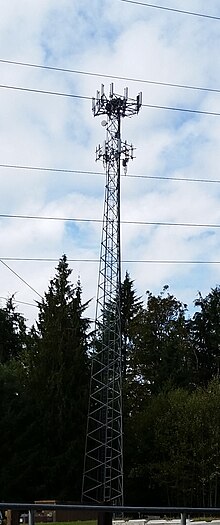Cellular tower

|
|
| Type | cellular telephone site |
|---|---|
| First production | 20th Century |
A cell site or cell tower is a cellular telephone site where antennae and electronic communications equipment are placed — typically on a radio mast, tower, or other raised structure — to create a cell (or adjacent cells) in a cellular network. The raised structure typically supports antennae and one or more sets of transmitter/receivers transceivers, digital signal processors, control electronics, a GPS receiver for timing (for CDMA2000/IS-95 or GSM systems), primary and backup electrical power sources, and sheltering.
In Global System for Mobile Communications (GSM) networks, the correct term is Base Transceiver Station (BTS), and colloquial synonyms are "mobile phone mast" or "base station". The term "base station site" might better reflect the increasing co-location of multiple mobile operators, and therefore multiple base stations, at a single site. Depending on an operator's technology, even a site hosting just a single mobile operator may house multiple base stations, each to serve a different air interface technology (CDMA2000 or GSM, for example).
Some cities require that cell sites be inconspicuous; they can be blended with the surrounding area or mounted on buildings or advertising towers. Preserved treescapes can often hide cell towers inside an artificial tree or preserved tree. These installations are generally referred to as concealed cell sites or stealth cell sites.
The working range of a cell site (the range which mobile devices connects reliably to the cell site) is not a fixed figure. It will depend on a number of factors, including, but not limited to:
...
Wikipedia
